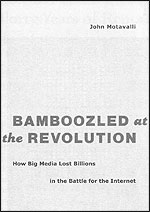
Bamboozled at the Revolution: How Big Media Lost Billions in the Battle for the Internet
John Motavalli
Viking Press. 320 Pages. $26.95.Steve Case’s resignation as chairman of AOL Time Warner in January came almost three years to the day after the announcement of the merger of the biggest online service and the biggest media company. It wasn’t exactly unexpected. In fact, it felt like the final shoe had dropped. Gerald Levin, Time Warner’s chief executive officer (CEO) who led his company into the merger, had quit almost a year earlier. Bob Pittman, once AOL’s very successful CEO, had been forced out as chief operating officer of the merged companies the previous summer. Last fall, Ted Turner tried to lead a boardroom revolt against Case. Case survived, but not for long.
So what went wrong? How could these two powerhouses fail to find the synergy they talked about so loudly three years before? How did the media merger of the century become just another family feud? How did things get this way? Second-day analysis stories and TV pundits found all kinds of reasons for the downfall of the new-media wunderkind: the slowdown of AOL’s core online-services business; disappointment among stockholders, and anger of former Time Warner people who had seen their 401K accounts washed away. The deeper reason may have been a profoundly dysfunctional corporate culture at Time Warner, if you follow the logic of John Motavalli’s book, “Bamboozled at the Revolution: How Big Media Lost Billions in the Battle for the Internet.” Published last fall, “Bamboozled” focuses on the last decade in the lives of Case and Levin, et al.—the years of the Internet bubble. The book opens with Jerry Levin’s announcement in 1993 that Time Warner intended to spend five billion dollars on a new-media project called the Full Service Network that went nowhere. It closes with an epilogue apparently written in mid-2002, as AOL Time Warner took a $54 billion charge to reflect the plummeting value of the combined businesses. In between it provides play-by-play coverage of the company’s attempts to develop online products and presence—Time Inc. Interactive, Time Inc. New Media, Pathfinder, Time Warner Digital Media, Time Warner Online, GoTo, Entertaindom.
Documenting Media Company Crashes
Motavalli witnessed most of this close-up as a computer and Internet columnist for the New York Post and a reporter for Adweek and Inside Media. Nor is Time Inc. the only media giant in his sights. “Bamboozled” is a detailed survey of the flailings of the biggest media companies over the past decade—Hearst and Disney and NBC and News Corp. among them—as they tried to come to grips with online services and the Internet.
It’s a book filled with big egos in big offices; big plans rolled out with big fanfare, then sunk by big flaws that resulted in big losses. When Motavalli writes about Time Warner, he waxes positively cinematic. “Bamboozled” describes with relish and great detail a self-satisfied corporate culture that perpetuated personal fiefdoms and spread decision-making power too thin. He elevates personal clashes between executives to the level of myth and marshals a cast of characters that is Homeric or, even better, Tom Wolfian.
As his title implies, Motavalli is fascinated by how much these media companies spent on new-media ventures and how little they got for it. He reports, for example, that in 1994 and 1995 Time Warner had opportunities to buy significant pieces of Netscape and Yahoo! and form a joint venture with AOL that would make it a major investor. It turned down all of them and instead made an investment in a company called Open Market. Who? His point exactly.
If Motavalli respects any of the personalities he covers it would be the AOL people—Case, Pittman and particularly Ted Leonsis, a utility infielder who has held several positions with AOL, most recently vice chairman.
“Bamboozled” also distinguishes between the giant media companies like Time Warner and Disney and more focused companies. Newspaper companies, in particular, “… recognized the promise and threat of the online world earlier than magazines and TV because it clearly impacted them more directly,” Motavalli quotes Tribune Company executive Gene Quinn.
But companies like Disney and Time Warner and their ilk learned little. Motavalli’s notebooks yield up example after example of hubris and ignorance. The very volume of his evidence makes his book a dizzying whirl of names and years and numbers, but this central fact of the book is also it’s central failing: There’s no learning going on here. It’s bad enough that the Time Warner executives from Levin on down weren’t developing any understanding of the Internet, but what’s worse is that Motavalli doesn’t, either.
Missing the Larger Questions
His stories of drive-by character assassination in the executive suites create more heat than light. Nowhere does he ask the basic question: Does the output of the media companies really have a place on the Internet? Just because Time Warner (and News Corp. and NBC and Microsoft and a few hundred other companies) have spent the last decade convinced that the Internet is their next playpen doesn’t mean that it is actually “media” in any way that’s meaningful to (that is, that will ever make a profit for) these companies.
He comes close when he writes about Leonsis in June 1995, at a meeting with AOL’s content partners, companies who had done high-dollar deals to provide content to the service. The relationship was increasingly tense because AOL had gone from a million members at the end of the previous year to three million by the time of the meeting, from 250 employees to 2,000. It had become a medium unto itself in the process and was developing in-house content like the “Motley Fool.” And it was telling the partners that henceforth it would be competing with them to sell advertising.
Leonsis, writes Motavalli, laid out for the assembled media company representatives his view of what would succeed online, which he called “The Five C’s”:
- Content that is programmed, not aggregated.
- Community that is endemic to the programming.
- Commerce that is part and parcel of the channel.
- Companion Web sites and CD-ROM’s that are connected properties.
- Context and point of view.
While Point Four was more relevant when the Internet was still in its infancy, Leonsis’s blueprint has not been disproved in the years since he laid it out. Portals and search engines and eBay and Matt Drudge and instant messaging and bloggers all fall within this vision.
RELATED ARTICLE
"'Small Pieces Loosely Joined'"
- David DeJeanNow skip forward 180 pages and seven years to almost the present. Levin is gone, and the technology that would support his Full Service Network never has arrived: Its latest incarnation, “broadband” (high-speed Internet connections that run on cable TV or telephone lines), is being treated by consumers as an expensive luxury, not a necessity. AOL Time Warner’s magazines still aggregate their print content for the Web, pretty much as they did for Pathfinder in 1994. There is little indication of any communication, let alone synergy, between Time Inc. and AOL and, even if there were, there’s no money to be made in online content.
“There is little doubt by this point that, indeed, the deal had been a disaster. Moreover, Levin’s dream of a hyper-connected, Jetsons-style AOL Time Warner, full of synergies and explosive growth, had failed as well …,” writes Motavalli. And that’s where he leaves his cautionary tale. Readers who are themselves inside the media might appreciate more thoughtful consideration of the “what ifs” of the stories told here, but readers on the outside will find Motavalli’s ability to successfully infuse corporate deal-making with a car-chase sensibility very entertaining, if not particularly enlightening. And when you think about it, perhaps that’s appropriate. We might not have learned much about the Internet yet, but it has certainly been a hell of a ride.
David DeJean, a 1978 Nieman Fellow, went from newspapers to new technologies and has watched videotex become online services and then morph into the Internet while writing about and working with computers and communication technologies in a variety of languages, including English and FORTRAN.



